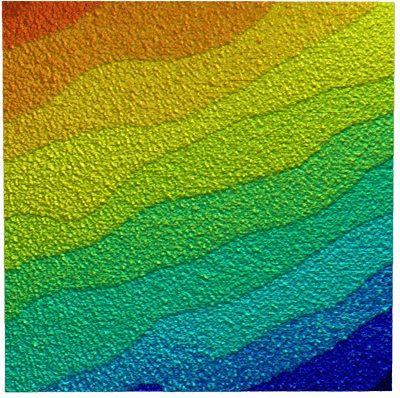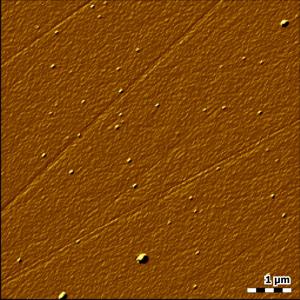原子力显微是用于诸如表面粗糙度之类的度量的最流行技术之一,因为它具有以纳米级分辨率定量测量x,y和z方向的能力。
原子力显微镜是为数不多的能够定量测量表面所有3个维度的工具之一:横向(x和y)和高度(z)。与其他依赖于电子与材料相互作用的高分辨率微观表征方法不同,原子力显微镜中针尖与样品之间存在机械接触,能够精确测量样品的形貌和表面纹理。原子力显微镜(AFM)横向分辨率为5-10nm,纵向分辨率为亚纳米级,是一种有效的表面定量测量仪器。这种强大的定量测量与样品表面的灵活性结合在一起:除了可被放入仪器外,对样品没有任何要求。对样品表面形貌的定量测量可以实现如粗糙度轮廓、发现表面不规则性等重要的计量测量,以及实现如偏度和峰度等的更先进的测量。的更先进的测量。
原子力显微镜中有多种模式可用于测量表面粗糙度,这些模式因接触类型而异。最简单的模式是接触模式,在接触模式下,尖端以恒定的悬臂偏转被“拖”过表面。用户定义尖端被“拖”过表面时的载荷,以便可以为坚硬、结实的材料选择较重的载荷,为较软的材料选择较轻的载荷。然后仪器中的z轴压电管上的反馈回路使悬臂的偏转在整个图像中保持恒定。通过此z轴压电运动可提供形貌信息。
测量表面形貌(从而测量表面粗糙度)的较温和模式是轻敲模式。这是一种动态模式,其中尖端以共振频率振荡,因而尖端以恒定的振幅轻柔地与表面相互作用。用户定义尖端在表面上成像时的振动幅度,以便为坚固的材料选择较大的幅度,为较软的材料选择较小的幅度。然后,仪器中z轴压电管上的反馈回路使悬臂振幅在整个图像中的保持恒定。通过此z轴压电运动可提供形貌信息。使用这两种模式,几乎任何表面形貌都可以成像,从软生物细胞,到聚合物,再到更坚硬的半导体和金属。
存在多种参数来量化表面粗糙度。粗糙度值可以从横截面轮廓(线)或表面(面积)计算。最常见的粗糙度参数依赖于计算与平均线或平面的垂直偏差。因此,只有提供z轴的定量测量的仪器才能提供粗糙度分析数据。如果图像给人三维的“印象”,但三维的高度没有量化(如扫描电镜图像),则无法对其进行定量粗糙度分析。
计算的两个最常见的粗糙度参数是相对于平均值的算术平均值偏差和平均值的均方根平均值偏差。 对于要分析区域的图像,算术平均值称为Sa,并定义为\[\frac{1}{n}\sum_{i=1}^{n}\left | y_{i} \right |\] 同样,RMS粗糙度称为Sq,定义为 \[\sqrt{\frac{1}{n}\sum_{i=1}^{n}y_{i}^{2}}\]
也可以进行更复杂的粗糙度测量。 例如,可以测量样品的偏斜度,该偏度可以度量表面形貌的不对称性,并将其定义为 \[\frac{1}{nRq^3}\sum_{i=1}^{n}y_{i}^{3}\] 峰度给出了表面z值分布的尾部信息,定义为 \[\frac{1}{nRq^4}\sum_{i=1}^{n}y_{i}^{4}\] 在所有这些定义中,y是图像中给定像素(i)下的高度(z)。
用AFM进行形貌测量的示例
原子力显微镜部分用作一个度量工具的原因是它在x,y和z上的出色分辨率。这里是一张收集到的钛酸锶(SrTiO3)的AFM图像,它是一种钛和锶的氧化物,呈现钙钛矿结构,用作氧化物基的薄膜和高温超导体生长的基底。这种材料形成层状结构,其中各层仅几埃厚。 AFM可以轻松处理此类材料并对这些结构进行成像。在此1.1µm x 1.1µm图像中,钛酸锶层很容易观察到。由于样品制备过程中的非理想终止过程,每层的RMS粗糙度约为0.125纳米。下图显示了横截面轮廓以及将每个样本高度的像素数进行分级的直方图。在横截面轮廓和直方图中,都清楚地看到了大约4埃的层厚,揭示了AFM在z轴的出色分辨率。
用AFM进行表面粗糙度测量的实例
对于某些应用,需要将蓝宝石或玻璃表面抛光至亚纳米粗糙度。 此处获得的图像显示出抛光痕迹和表面上的小污染物颗粒。 图像以动态模式记录。
系统: NaniteAFM 10µm 扫描范围 连接至 C3000 控制器
悬臂: NCLAuD (Nanosensors)
图像处理: Nanosurf 报告软件
Sa = 0.12nm
表面上的颗粒分别引起较大的49和2770的偏度和峰度值。



